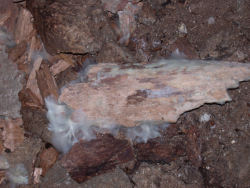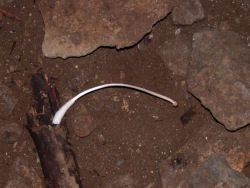Cave Fungi


Cave Fungi is probably a wrong term. Fungi grow everywhere, and they do not need light, so growing inside a cave does not require any adaption. They grow in the top soil and they grow in cave clay, especially if there is a piece of wood, which most likely brought the spores with it into the cave. So as a result cave fungi are not fungi adapted to caves, but simply normal fungi, at least several species, where caves are a general part of their habitat. However, the fungal morphology changes under cave conditions.
Yet cave fungi are an often overlooked cornerstone of cave life. Nearly 1030 species are known from caves worldwide, and in Austria about 100 large fungi have been found in caves. Nutritionally, most cave fungi are saprotrophic, followed by parasites, there are only a few mycorrhizal fungi.
Fungi are growing as a mycelium, the vegetative part of a fungus or fungus-like bacterial colony, consisting of a mass of branching, thread-like hyphae. They do not need sunlight for this, just enough rotting plants. When two compatible monokaryotic mycelia join and form a dikaryotic mycelium, that mycelium may form fruiting bodies such as mushrooms. Fruiting bodies or sporocarps are multicellular structures on which spore-producing structures, such as basidia or asci, are formed.
As caves are close to the natural habitat of fungi, although there is generally not enough food for them, it is easy to grow fungi inside caves, by just providing the food. During the 19th and 20th century hundreds or even thousands of caves were used to grow fungi, typically champignons (Agaricus). But unfortunately they are very delicate and so many mushroom farms had to close because they were contaminated by bacteria, other fungi or another mushroom disease.
Probably the most famous cave fungus originates from a cave in the little French town Roquefort. There is a limestone cave, a karst cave, above the village in the cliff. Long time ago a shepherd left his food in the cave while he was herding his sheep. The food was a piece of cheese and a loaf of bread packed in a cloth. It is not clear what happened exactly, but it seems he forgot his food in the cave, which was generally not a big problem, as the cool cave air and the high carbon dioxide in the air preserved the food like a refrigerator. But when he came back, the food was covered by a green blue fungus, Penicilium roqueforti. He thought about throwing it away, but food was expensive, and he was poor, so he tried to eat it. He was very astonished as he learned that the cheese, a fresh cheese, which before tasted quite boringly, was now much better with a special taste. The bread was not very good with the fungus, but he had the idea to seed the next load of cheese with crumbs of the moldy bread to make it tasty.
But fungi can also cause damages in caves. Unfortunately many caves with prehistoric paintings have the problem of fungi invading the paintings. In the sixties the caves of Lascaux and Altamira were closed to protect the paintings. Too many visitors caused the growth of green algae, of fungi, and other damages. The number of visitors was drastically reduced, the caves were more or less locked down, except for some scientists. This stopped the problems for a while, but now black spots have been discovered on the paintings (JUL-2007) and were identified as fungi. Two fungi, ulocladium and gliomastix, grow on a layer of existing bacteria.
Finally, we should not forget that fungi in caves can affect cave visitors and cave animals. Some diseases are caused by fungal spores in the cave air, and cavers should wear breathing masks in these caves. A very important representative is histoplasmosis (Histoplasma capsulatum). Bats can also be damaged by fungi; the fungus Pseudogymnoascus destructans causes white-nose syndrome (WNS) in them.
Literature
- Peter Febbroriello (1982):
Cave Fungi,
Speleo Digest 1982:268.
- Peter Febbroriello (1982):
Cave Fungus: Potential Danger to Cavers in the Northeast,
Speleo Digest 1982:269.
 Histoplasmosis
Histoplasmosis White-Nose Syndrome
White-Nose Syndrome Search DuckDuckGo for "Cave Fungi"
Search DuckDuckGo for "Cave Fungi" Mycelium - Wikipedia (visited: 09-APR-2021)
Mycelium - Wikipedia (visited: 09-APR-2021) Fungi in the Ramioul Cave
Fungi in the Ramioul Cave
 Index
Index Topics
Topics Hierarchical
Hierarchical Countries
Countries Maps
Maps